Rebecca Thomas
DESW
Competence-Level Prediction and Resume & Job Description Matching Using Context-Aware Transformer Models
Nov 05, 2020



Abstract:This paper presents a comprehensive study on resume classification to reduce the time and labor needed to screen an overwhelming number of applications significantly, while improving the selection of suitable candidates. A total of 6,492 resumes are extracted from 24,933 job applications for 252 positions designated into four levels of experience for Clinical Research Coordinators (CRC). Each resume is manually annotated to its most appropriate CRC position by experts through several rounds of triple annotation to establish guidelines. As a result, a high Kappa score of 61% is achieved for inter-annotator agreement. Given this dataset, novel transformer-based classification models are developed for two tasks: the first task takes a resume and classifies it to a CRC level (T1), and the second task takes both a resume and a job description to apply and predicts if the application is suited to the job T2. Our best models using section encoding and multi-head attention decoding give results of 73.3% to T1 and 79.2% to T2. Our analysis shows that the prediction errors are mostly made among adjacent CRC levels, which are hard for even experts to distinguish, implying the practical value of our models in real HR platforms.
Superimposition of eye fundus images for longitudinal analysis from large public health databases
Jul 18, 2018



Abstract:In this paper, a method is presented for superimposition (i.e. registration) of eye fundus images from persons with diabetes screened over many years for diabetic retinopathy. The method is fully automatic and robust to camera changes and colour variations across the images both in space and time. All the stages of the process are designed for longitudinal analysis of cohort public health databases where retinal examinations are made at approximately yearly intervals. The method relies on a model correcting two radial distortions and an affine transformation between pairs of images which is robustly fitted on salient points. Each stage involves linear estimators followed by non-linear optimisation. The model of image warping is also invertible for fast computation. The method has been validated (1) on a simulated montage and (2) on public health databases with 69 patients with high quality images (271 pairs acquired mostly with different types of camera and 268 pairs acquired mostly with the same type of camera) with success rates of 92% and 98%, and five patients (20 pairs) with low quality images with a success rate of 100%. Compared to two state-of-the-art methods, ours gives better results.
* This is an author-created, un-copyedited version of an article published in Biomedical Physics \& Engineering Express. IOP Publishing Ltd is not responsible for any errors or omissions in this version of the manuscript or any version derived from it. The Version of Record is available online at https://doi.org/10.1088/2057-1976/aa7d16
 Add to Chrome
Add to Chrome Add to Firefox
Add to Firefox Add to Edge
Add to Edge